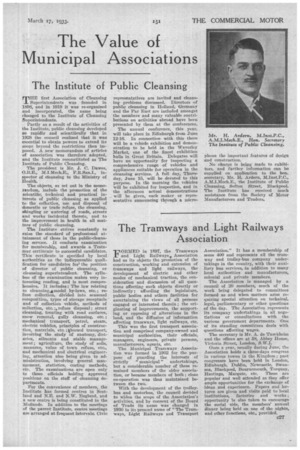The Tramways and Light Railways Association
Page 77

If you've noticed an error in this article please click here to report it so we can fix it.
FORM:ED in 1897, the. Tramways and Light Railways* Association had as its objects the promotion of the construction, working and extension of tramways and light railways, the development of electric and other modes of mechanical traction, the consideration and discussion of all questions affecting such objects directly or indirectly ; affording the legislature, public bodies and others facilities for ascertaining the views of all persons engaged or interested therein; the originating of improvements, the supporting or opposing of alterations in the land, and the diffusion of information affecting tramways, light railways, etc.
This was the first transport association and comprised company-owned and municipal authbrities, their officials, managers, engineers, private persons, manufacturers, agents, etc.
The Municipal Tramways Association was formed in 1902 for the purpose of guarding the interests of strictly " municipal " undertakings, but a considerable number of these remained members of the older association, or became members of both ; close co-operation was thus maintained between the two.
With the development of the trolleybus and motorbus, the council decided to widen ihe scope of the Association's activities, and by consent of the Board of Trade its name was changed in 1930 to its present name of "The Tramways, Light Railways and Transport Association." It has a membership of some 400 and represents all the tramway and trolley-bus company undertakings in the country, with their auxiliary bus services, in addition to many local authorities and manufacturers, colonial and private members.
The Association is managed by a council of 20 members; much of the work being delegated to committees formed as and when matters arise requiring special attention on technical, legal, parliamentary or other questions of the day. The Association represents its company undertakings in all negotiations or consultations with the various government departments. One of its standing committees deals with questions affecting wages.
The secretary is Mr. A. de Turckheim and the offices are at 58, Abbey House, Victoria Street, London, S.W.1.
Once a year, usually during June, the Association holds a three-days congress in various towns in the Kingdom; past congresses have been held in London, Edinburgh, Dublin, Newcastle, Swansea, Blackpool, Bournemouth, Torquay, Hastings, Margate, etc. These are popular and well attended as they offer ample opportunities for the exchange of ideas and experience. Papers and lectures are given and visits paid to local institutions, factories and works ; opportunity Is also taken to encourage • the social side, the members' annual dinner being held on one of the nights, and other functions, etc., provided.




































































































































































